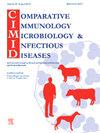Dynamics of high pathogenicity avian influenza virus infection with multiple introductions in a crow flock in an urban park in Hokkaido, Japan
IF 2
3区 农林科学
Q4 IMMUNOLOGY
Comparative Immunology Microbiology and Infectious Diseases
Pub Date : 2025-06-01
DOI:10.1016/j.cimid.2025.102367
引用次数: 0
Abstract
Since 2021, high pathogenicity avian influenza viruses (HPAIVs) of the H5N1 clade 2.3.4.4b has been circulating globally, not only in domestic poultry but also in wild birds, both migratory and resident species. In March to May 2022, March to April 2023, and January to April 2024, crow die-offs were reported in an urban garden in Hokkaido, Japan, raising suspicions of HPAIV infection. Since August 2022, all dead carcasses were investigated for HPAIV detection and isolation. Phylogenetic analysis of the H5 hemagglutinin gene revealed that all detected HPAIVs belonged to clade 2.3.4.4b, a dominant lineage in Hokkaido since early 2022. Two distinct subgroups were identified: G2d (in 2022–2024) and G2a (in 2024). A maximum clade credibility tree, based on concatenated nucleotide sequences of the isolates, suggested that multiple distinct types of HPAIVs were introduced into the garden in rotation during the winters of 2022–2023 and 2023–2024. Infectious HPAIVs were isolated not only from the lungs and brains but also from the rectal contents of the dead crows, with no apparent difference in viral titers between the two subgroups. The case reproduction numbers of HPAIV infection in the crow flock ranged from 0.52 and 1.57 in the spring of 2022 and from 0.55 to 1.78 in the spring of 2023, suggesting that the contiguous HPAIV infections in the crows were due to multiple introductions into the flock. Crow can play a key role of potential spread to other animals, poultry and wildlife in urban areas or humans in rural areas.
日本北海道某城市公园乌鸦群中多次引入的高致病性禽流感病毒感染动态
自2021年以来,H5N1进化支2.3.4.4b型高致病性禽流感病毒(hpaiv)在全球流行,不仅在家禽中流行,而且在候鸟和留鸟中流行。在2022年3月至5月、2023年3月至4月和2024年1月至4月,日本北海道的一个城市花园报告了乌鸦死亡,引起了对HPAIV感染的怀疑。自2022年8月以来,对所有死亡尸体进行了HPAIV检测和分离调查。H5血凝素基因的系统发育分析显示,所有检测到的hpaiv都属于2.3.4.4b进化支,这是北海道自2022年初以来的一个优势谱系。确定了两个不同的亚群:G2d(2022-2024年)和G2a(2024年)。基于分离株核苷酸序列的最大进化枝可信度树表明,在2022-2023年和2023-2024年冬季,多种不同类型的hpaiv被轮作引入菜园。传染性hpaiv不仅从死乌鸦的肺和大脑中分离出来,而且从死乌鸦的直肠内容物中也分离出来,两个亚组之间的病毒滴度没有明显差异。2022年春季和2023年春季乌鸦群中HPAIV感染的病例繁殖数分别为0.52 ~ 1.57和0.55 ~ 1.78,提示乌鸦连续感染HPAIV是由于多次引入乌鸦群所致。乌鸦可以在城市地区的其他动物、家禽和野生动物或农村地区的人类中发挥关键作用。
本文章由计算机程序翻译,如有差异,请以英文原文为准。
求助全文
约1分钟内获得全文
求助全文
来源期刊
CiteScore
4.60
自引率
0.00%
发文量
102
审稿时长
40 days
期刊介绍:
Comparative Immunology, Microbiology & Infectious Diseases aims to respond to the concept of "One Medicine" and to provide a venue for scientific exchange. Based on the concept of "Comparative Medicine" interdisciplinary cooperation between specialists in human and animal medicine is of mutual interest and benefit. Therefore, there is need to combine the respective interest of physicians, veterinarians and other health professionals for comparative studies relevant to either human or animal medicine .
The journal is open to subjects of common interest related to the immunology, immunopathology, microbiology, parasitology and epidemiology of human and animal infectious diseases, especially zoonotic infections, and animal models of human infectious diseases. The role of environmental factors in disease emergence is emphasized. CIMID is mainly focusing on applied veterinary and human medicine rather than on fundamental experimental research.

 求助内容:
求助内容: 应助结果提醒方式:
应助结果提醒方式:


